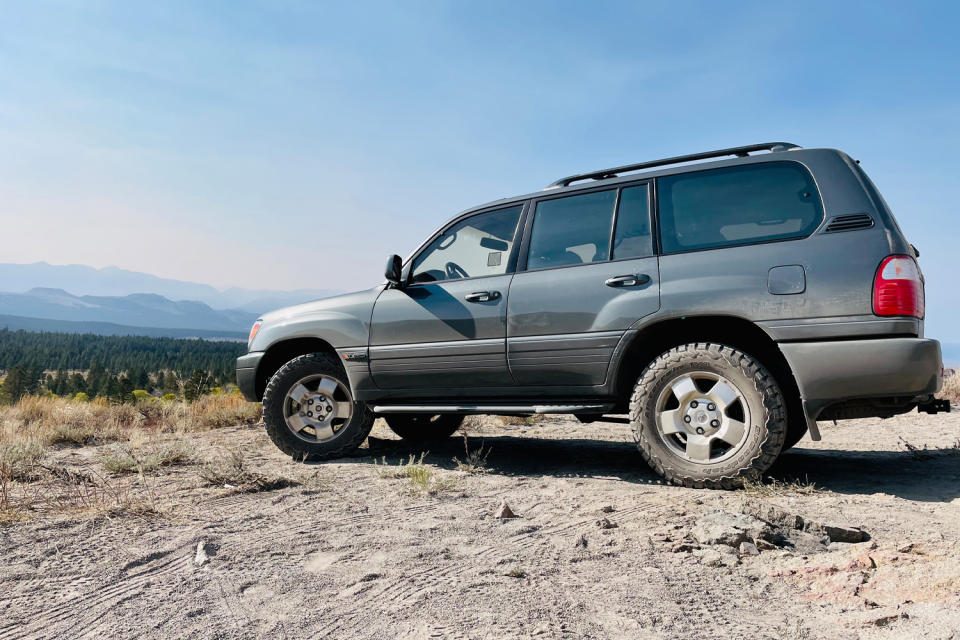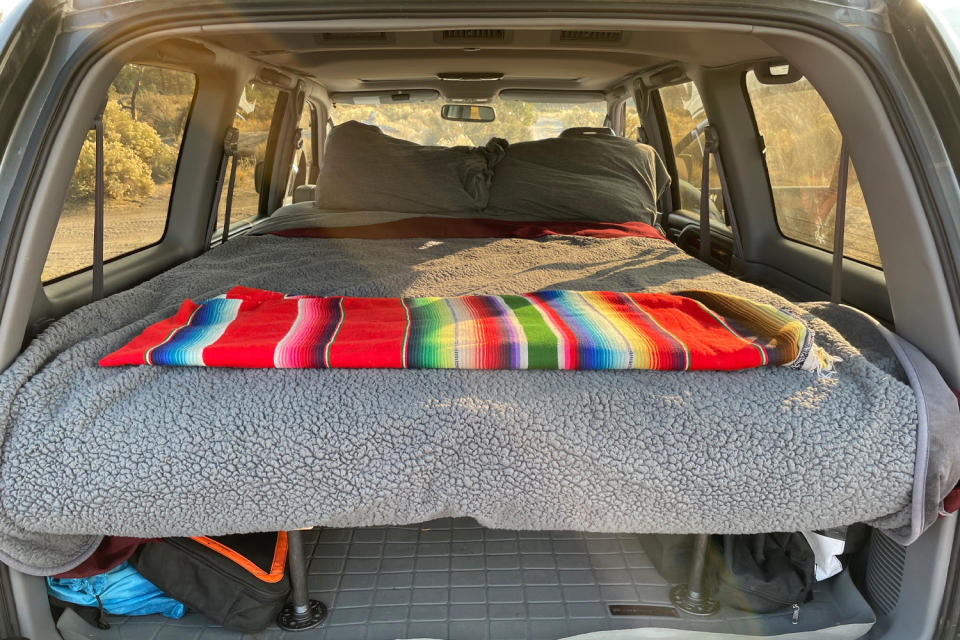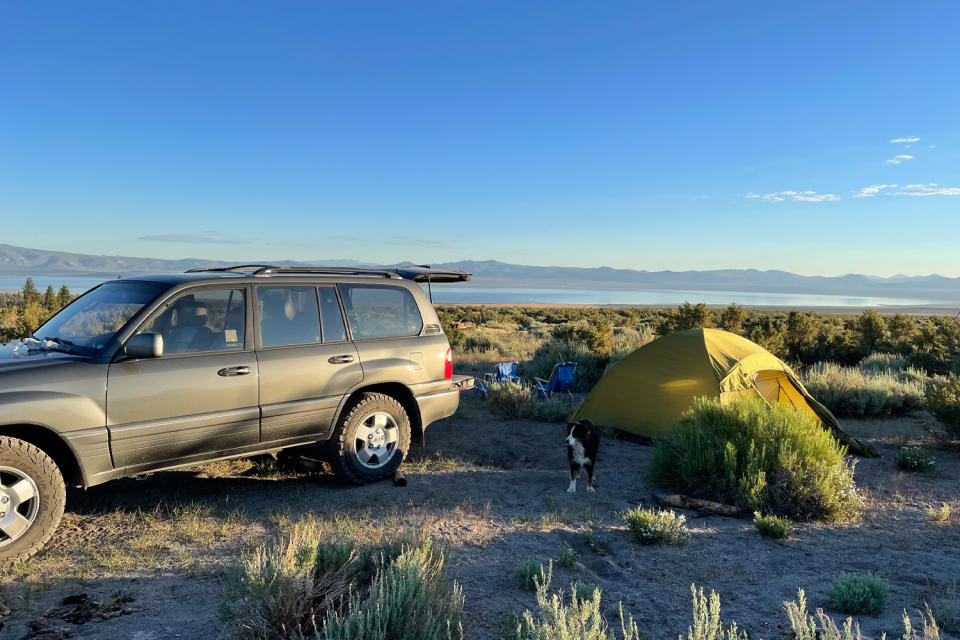Why I Chose a Used Lexus LX 470 Over a Brand-New Ford Bronco

Everyone knows where the Toyota Land Cruiser stands on the podium of sport utility vehicles. If unsure, look to those who also take home medals. Toyota’s war-born off-roader was inspired by America’s iconic Willys Jeep, yet long ago surpassed its role model in reliability and used-market appeal.
If you’ve ever driven a later-model Land Cruiser, you know its reputation wasn’t earned merely by its off-road capability or half-million-mile motor. It also helped set the standard for rugged luxury, a fact made undeniable when Toyota released the opera-ready Land Cruiser J80 clone, the quite-rare Lexus LX 450 (1996-97) and its more common, classier upgrade, the Lexus LX 470.
I’m not one for formalwear, but if you can look as good as everyone else at the party, be more comfortable and pay less to achieve that balance, wouldn’t you? That’s why I bought my 1999 Lexus LX 470, a tuxedo-clad Land Cruiser that’s one of the best values in capable, used off-roaders today.
Moreover, now that Toyota has permanently garaged its legendary SUV for the American market, the Lexus LX is no longer the understudy.

How I Found My Lexus LX 470
I wasn’t always an LX stan. In fact, I was enamored by the new Ford Bronco.
However, Ford’s clumsy rollout of that revived icon, coupled with the fact that I don’t need that much capability, made me especially susceptible to the cajolery of a buddy who returned from an extended African safari where he spent his time living out of a 79-Series Land Cruiser. Once back Stateside, he evangelized all things Toyota-built. Plus, car-guy code states that a trusted pal should not be ignored. While not naive to Land Cruiser lore, I previously brushed them off due to scarcity and budget.
“Right,” my buddy told me, “but Lexus makes the same truck, it’s cheaper and it’s everywhere.”
In its authentic form, the Land Cruiser name carries a good deal of weight, literally and financially. Aspiring Lexus owners compete in a smaller, often more devoted niche.
Bring a Trailer drove that reality home after I place a last-minute bid on a particularly sharp 2001 Lexus LX 470 — my $21,000 doubled in about 30 seconds. And so I perused the market for GX 460s and 470s, known as the Land Cruiser Prado everywhere else. The 470 ran from 2003 to 2009 with the same 2UZ-FE 4.7-liter V8 as my LX. It was replaced in 2010 by the GX 460, powered by Toyota’s slightly more fuel-friendly 4.6-liter 1UR-FE motor.
A few dealerships specialize in making these rigs overland ready with AHC (active height control) swaps, new wheels, timing belt and water pump service, and a combination of roof rack and sliders. But I’m drawn to the J100-Series body, the hippy, hulking version built from 1998 to 2007. They’re physically omnipresent, with gear-carrying capacity beyond that of my minimally modified 2008 Nissan Xterra, a highly underrated SUV that carried me over 200,000 adventurous miles around the American West.
More Like This
In an act of desperation after weeks of shopping around the country, I put down $5,000 on a 2006 Land Cruiser in Austin, TX. “Act fast,” the dealer said. “We can’t keep these things on the lot.” So I flew to Austin, and immediately regretted it.
Despite fewer than 150,000 miles, the windows wouldn’t close. The sickly orange lift-gate hinges were days from flaking onto the pavement, and the tapioca-thick frame coating led me to believe the truck had been stored in an aquarium. Clearly it was a flood victim, given its Midwest origins. I assume the truck found its way back into the market because the 2UZ-FE motor simply hates to not start.
My deposit graciously returned, the next day I would travel directly from the airport to the desk of a small Reno dealership advertising a 1999 LX 470 with only 98,000 miles. The interior showed its age only in style. The body also solid, it displayed a single dime-sized rust spot above the windscreen and sun damage on the exterior window trim. It needed new tires, a battery and timing belt, and water pump service, common to these trucks at every 100,000 miles.
The dealer gave me the battery, half of the cost of some new KO2s, and our mechanic sold me a set of Tundra rims for $200. “I can’t believe how clean this thing is,” he said. I was out the door at around $21,000.

The Pros (and Cons) of My Lexus LX 470
Let’s talk tailgates. I mean both the actual part of a vehicle and the act of sharing lawnmower beers and tubed meat in ski-resort parking lots.
The practicality of the wide-mouth, clamshell design tailgate of the LX 470, a Land Cruiser hallmark, is virtually unmatched. Not one owner of an LX will disagree with me. The lower gate serves as my cook table and extends your equipment staging area by almost two feet. Among many other benefits, it’s ideal for splitboard-touring equipment checks and acts as a platform from which my dog can sit in judgment of tourists. I spend a great deal of time in the rear of my truck, and I can’t imagine finding another vehicle that suits this need as well as the LX 470. It’s also terrific for getting up onto my rudimentary sleep platform.
I’m sure more than a couple of readers have quickly scanned this article to learn, and likely pounce, on my take on the AHC, a standard feature on the LX. This hydraulic body-height adjustment system lifts or lowers the vehicle according to surface conditions, ranging from “low” to sometimes “extra high.” It should last as long as the truck, with proper maintenance.
Detractors often mention the risk of it breaking down in remote areas, that it’s not easily fixed in the field and that it’s certainly not cheap. Noted. (It can also be temporarily affected by sub-zero temperatures.) But I argue that if your plan includes extended off-grid overlanding, then suspension is merely the beginning of your mod list. Your need for a different option doesn’t mean the AHC is inherently flawed.
For everyday camping, fire-road summits or snowy climbs, the AHC is a confident, fun feature to have underneath the sectional-sofa-like comfort of the LX’s leather-wrapped cabin.
More Like This
My list of superlatives includes the absence of Toyota’s infotainment display — the Commodore VIC-20 of automotive interfaces — the absurdly smooth ride quality provided by the variable suspension dampening modes and the ideal integration of usable luxury features, such as heated seats, power-retractable mirrors (useful in my tight garage) and push-button rear-window vents. All useful. It also has the most intuitive automatic climate control of any vehicle I’ve driven and boasts popemobile visibility throughout the helm.
An inherent advantage of older luxury vehicles is the lack of superfluous features. Truth be told, I’m not sure I’d want sonar or adaptive cruise control. That said, there are the standard older-vehicle flaws. I don’t particularly like that an iceberg calves every time I turn the ignition. The in-town mileage is brutal, not surprising given that it weighs a little under 6,000 pounds and is full-time four-wheel drive. I should probably just shop for an e-bike.
The interior requires a lot of attention, too. I’m all-in on seat protection options to alleviate the Godzilla-like destruction that comes standard with crud-loving Australian Shepherds. The factory cup holders are useless, probably designed by the same person responsible for the infotainment system. The roof rack had some sort of odd plastic degradation going on that demanded repainting, and then it didn’t go back together all that well. And I discovered a pack rat was considering moving into the engine bay this winter, likely a result of the tight housing market and all. We had it out.
Generally speaking, a 23-year-old vehicle will simply require more attention. Hoses. Clamps. Fuses. Rust. It’s like owning a home — there are always dishes to do. Oh, and it’s slow.

So Many Roads, So Little Fuel Economy
I’ve owned my LX 470 for a little less than a year, and it’s performed exactly as its reputation suggests. It rides beautifully.
I carried six adults and gear over four days of guiding in Yosemite National Park, served up an array of breakfast meals before several Truckee River float trips and spent nights staring through the sunroof at the Eastern Sierra starscape. It’s tackled rutty BLM roads thick with snow-melt and found us every dispersed campsite we sought.
It’s not even been modded much. I welded rock sliders from Coastal Offroad, applied some cool badges and assembled a sleep platform with steel plumbing pipe and scrap wood. It fits a queen-sized air mattress when the backseats are flat (I removed the third-row jump seats). I’m currently considering a front bumper and a roof rack, as the array of after-market modifications for this truck is impressive. Oh, and I added a new single-din stereo, which gave me a dashboard pocket and Bluetooth connectivity to boot.
I passed on the new Ford Bronco in favor of this partly because of the former’s outsized reputation — it’s something that’s going to become ubiquitous among people who throw couches on campfires. They’re all over Instagram. Being part of a group within a group appeals to me; it’s fun owning an old-school SUV hat’s earned the hashtag #IYKYK. Maybe I need more time for it to fully reveal itself. As of now though, my 23-year-old Lexus LX 470 has not once left me where I didn’t want to be.
Except, of course, at the gas pump.
More Like This
This article was featured in the InsideHook newsletter. Sign up now.
The post Why I Chose a Used Lexus LX 470 Over a Brand-New Ford Bronco appeared first on InsideHook.
The article Why I Chose a Used Lexus LX 470 Over a Brand-New Ford Bronco by Craig Rowe was originally published on InsideHook.